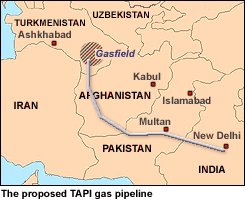
The intensive involvement of foreign companies in energy projects of Turkmenistan, the UN Security Council's sanctions against Tehran's nuclear program and as a consequence, the refusal of Europe and the United States from participation in energy projects of Iran, can leave Turkmenistan without a competitor in the field of energy security and transit.
More active talks around the Turkmenistan-Afghanistan-Pakistan-India gas pipeline (TAPI), which completely left the prospect of the Iranian gas pipeline Peace in the shadow, is evidence to it.
Development of Turkmenistan's energy projects with the participation of dozens of foreign companies brings this country to far ahead not only in natural gas exports, but also in the production of liquefied gas, in comparison to Iran.
In early August, the Turkmen government newspaper Neutral Turkmenistan reported on the achievement of record in the production of liquefied gas - 75,000 tons per day- at the Naip refinery. Moreover, after Shell and Repsol have refused to cooperate with Iran, this country has officially refused the project LNG (liquefied natural for the production of gas).
Today, Iran ranks second in the world after Russia on stocks of "blue fuel" with almost 30 trillion cubic meters of gas. Turkmenistan is in third place with reserves of more than 8 trillion cubic meters. Iran produces 110 billion cubic meters of gas a year, and Turkmenistan - 75 billion.
Despite this, domestic demand and production of gas is balanced in Iran (consumption is nearly equal to production), and it is necessary to develop major gas projects such as South Pars for gas export.
However, due to lack of investment and financing opportunities, only 10 phases of 24 project phases in the development of this field is completed through internal resources. The development of the remaining phases have not yet started or developed for a maximum of 50 percent.
After a delay of several years, the Hatam Ul-Anbiya structure belonging to the Islamic Revolutionary Guard Corps (IRGC) suspended the development of 15th and 16th phases of the South Pars project in July, 2010.
However, unlike Iran, detailed negotiations in the energy sector are underway in Turkmenistan.
While Iran gives promises to develop prospects of energy projects under contracts worth billions of dollars and increase the production of hydrocarbons, its northern neighbor has reached concrete results in the energy sector thanks to its pragmatism.
Earlier, a large delegation headed by U.S. Energy Department Regional Director Riaz Awan paid a visit to Turkmenistan. There he held discussions on energy cooperation. They discussed issues such as geological exploration, hydrocarbon processing, oil and gas deposits in the Turkmen sector of the Caspian Sea, as well as the implementation of projects on development of transport infrastructure for export of Turkmen energy resources to the world markets.
Turkmen President Gurbangulu Berdimuhammedov named the proposals by three U.S. oil companies and one oil company from the United Arab Emirates to develop oil fields in the Caspian Sea as "very successful and fruitful." The President instructed the relevant authorities to investigate these suggestions and begin to implement them. These companies have proposed drilling operations in 9 and 20 blocks in the Turkmen sector of the Caspian Sea.
While global oil and gas giants refuse to participate in Iran's energy projects one after another, Turkmenistan's national gas company Turkmengaz signed a contract to develop the country's largest field Yolotan, whose minimum reserves are estimated at 4 trillion cubic meters. The contracts were signed with China National Petroleum Company (CNPC) at $3.1 billion, the UAE international oil company "Petrofac" at $3.9 billion, Kuwaiti oil and gas company "Gulf" at $1.2 billion and the Korean company LG and Hyundai at $1.5 billion.
The list of companies that have invested in Turkmenistan is not limited to these companies. Malaysian Petronas, Dragon Oil owned by Britain and the United Arab Emirates, the Danish Maersk Oil, India's ONGC, Italy's ENI, and Germanic Wintershal and RWE Dea AG signed contracts with Turkmenistan as a result of the state support provided by the Turkmen government to foreign investment into the country. Based on the signed contracts, they are engaged in exploration and production of hydrocarbons at onshore and offshore fields.
In addition, Turkmenistan turned to China to allocate $4.1 billion as investments to develop the largest gas field Yolotan.
Turkmenistan's gas production doubled reaching 75 billion cubic meters a year in the past two years. This figure is expected to be tripled in the next 20 years. Based on BP's estimates, Turkmenistan's total gas reserves reach 8.1 trillion cubic meters, of which nearly half falls on the Yolotan field.
Turkmenistan's efforts aimed to diversify the gas transit routes are also a kind of warning to Iran. The country opened the Turkmenistan-Uzbekistan-Kazakhstan-China gas pipeline length 7.000 km in 2009. The pipeline delivers the Turkmen gas through Uzbekistan and Kazakhstan to China.
In addition, the negotiations on the TAPI gas pipeline have been intensified. During the past month, officials from four states have held several meetings to discuss the project.
TAPI project is an alternative to the Peace project, which involves supply of the Iranian gas from the South Pars field to Pakistan and India. India's refusal to participate in the Peace project cast doubt on its implementation.
According to the Turkmen State Agency, the country will make every effort to sign an agreement to sell natural gas through the TAPI gas pipeline project this year. The Turkmen gas is also expected to be delivered through the Nabucco gas pipeline from the Caspian region to Europe, thereby reducing its dependence on Russian gas and increase energy security in EU countries.

Comments
Post a Comment